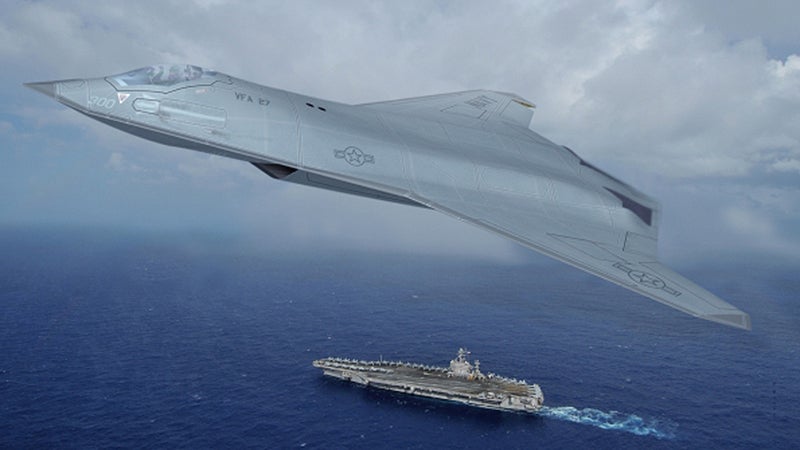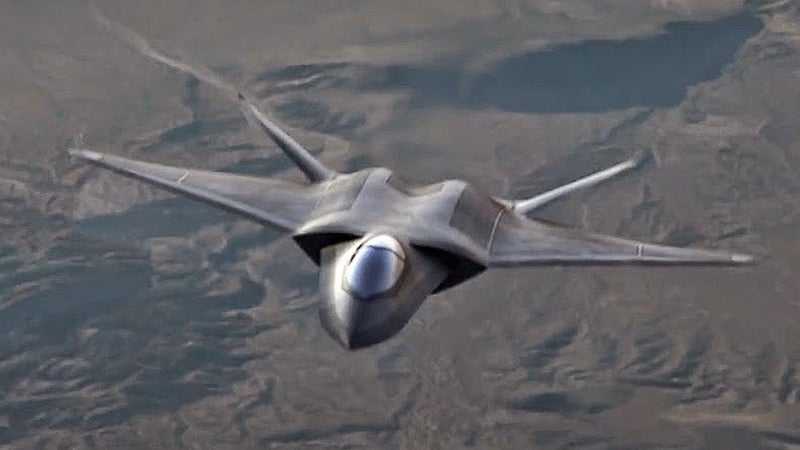
 |
Northrop Grumman's Idea Of A Sixth-Generation Fighter |
The fighter aircraft feature being highly maneuverable. The air intakes sit atop the fighter’s fuselage to maximize low-observability and the nose section is similar to the YF-23, with a bubble canopy, pointed radome and a chine-line along the nose leading edge.
Underneath, bulging weapons bays can be made out, as well as apertures possibly for optical targeting systems or even a laser. The exhausts are pushed forward along the jet’s upper fuselage to mask their heat signatures from lower viewing angles.
The idea is that combat aircraft can use solid-state laser systems defensively, creating a sanitized sphere of safety around the aircraft, shooting down or critically damaging incoming missiles and approaching aircraft with their laser turrets. They can also use such a system offensively, leveraging their stealth capabilities to sneak up on enemy aircraft and striking with speed-of-light accuracy.
Even attacking targets on the ground, such as individual people, with pinpoint precision, or shooting down ballistic missiles and other targets traditionally relegated to larger and much more complex ground or sea-based weapon systems, are possibilities.
The introduction of nimble and compact lasers on the aerial battlefield will likely allow fighter-sized combat aircraft designs to cease putting a premium on maneuverability, as lasers are speed-of-light weapons. In other words, as long as the enemy can be detected and is within the laser’s range, they are at risk of being fried regardless of how hard they try to evade via hard turns and other high-g maneuvers. Countermeasures will become more about evading initial detection, staying outside an opposing aircraft’s laser’s envelope, and confusing targeting sensors than out-maneuvering the adversary. In other words, the dogfights of the future will look nothing like they do today.
One issue pointed out by Northrop Grumman is that these lasers, along with future engines and avionics, will put out a huge amounts of heat, making thermal control a huge concern for stealthy aircraft. Infrared search and track systems, both air and ground based, are only becoming more sensitive and reliable as time goes on. As a result, future stealthy fighter aircraft will have to keep their cool in order to remain undetected over the battlefield.
One way the Pentagon and possibly some defense aerospace contractors are looking at dealing with this problem will be by using a large thermal accumulator to control the aircraft’s heat signature while using laser weaponry, although Northrop Grumman seems to be pursuing a different—albeit more shadowy—way of dealing with the problem. Flightglobal.com talked with Northrop Grumman Aerospace Systems President Tom Vice about the issue:
“Venting the heat offboard only raises the aircraft’s visibility to heat-sealing sensors. Another option is to develop a thermal accumulator, which is a path the Air Force Research Laboratory is pursuing under the INVENT program. An electrical accumulator stores the energy onboard in the same way as a hydraulic accumulator, releasing the latent energy as necessary to generate a surge of power.For a sixth-generation fighter like the ones depicted by Northrop Grumman, top-end speed and maneuverability may be sacrificed to some degree—at least, if the crank-kite flying wing design is used—in order achieve many other enhanced capabilities at an affordable cost. For instance, packing a laser system and long-range into a 9G tailless, supersonic fighter design may not only be prohibitively expensive, but also wasteful. By giving up maneuverability and high top-speed performance for enhanced stealth and greater fuel and weapons capacity, while relying on lasers instead of maneuverability for self defense, little is lost while much is gained.
But Northrop’s sixth-generation fighter concept eschews the accumulator concept for thermal management. According to Vice, such a system imposes a limitation on the laser weapon’s magazine size or firing rate, forcing the pilot to exit combat until the accumulator is refilled with energy. Northrop is pursuing a concept instead that does not rely on accumulators or offboard venting to manage the heat, but Vice declines to elaborate on the company’s specific approach to solving the thermal management problem.”

FA-XX program aims to replace the F/A-18E/F Super Hornet

Another design, from Lockheed sixth-generation fighter.
looks very much like Northrop’s own YF-23 Black Widow, an aircraft that lost to Lockheed’s YF-22 Lightning during the Advanced Tactical Fighter Competition of the early 1990s
Northrop Grumman Stealth Bomber Concept.
This is a clear extrapolation of what the company have already shown regarding their sixth generation fighter ambitions.


Post a Comment Blogger Facebook Disqus